When you hear the deep, resonant boom of a Native American powwow drum echoing across a gathering, you’re experiencing something far more profound than music.
You’re listening to what many Indigenous peoples call the heartbeat of Mother Earth herself. These magnificent instruments, central to powwow ceremonies and cultural celebrations across North America, carry within them centuries of tradition, spirituality, and community connection.
Whether you’re looking to buy your first powwow drum, deepen your understanding of Native American culture, or simply appreciate the artistry behind these sacred instruments, this comprehensive guide will walk you through everything you need to know about traditional Native American powwow drums.
From their rich history and spiritual significance to practical advice on purchasing authentic drums and learning proper playing techniques, we’ll explore every aspect of these remarkable cultural treasures.
Understanding powwow drums isn’t just about appreciating their sound—it’s about respecting a living tradition that continues to bind communities together, preserve ancestral wisdom, and provide a pathway for cultural revitalization among Indigenous youth. Let’s begin this journey into the heart of Native American musical tradition.
What Are Native American Powwow Drums?
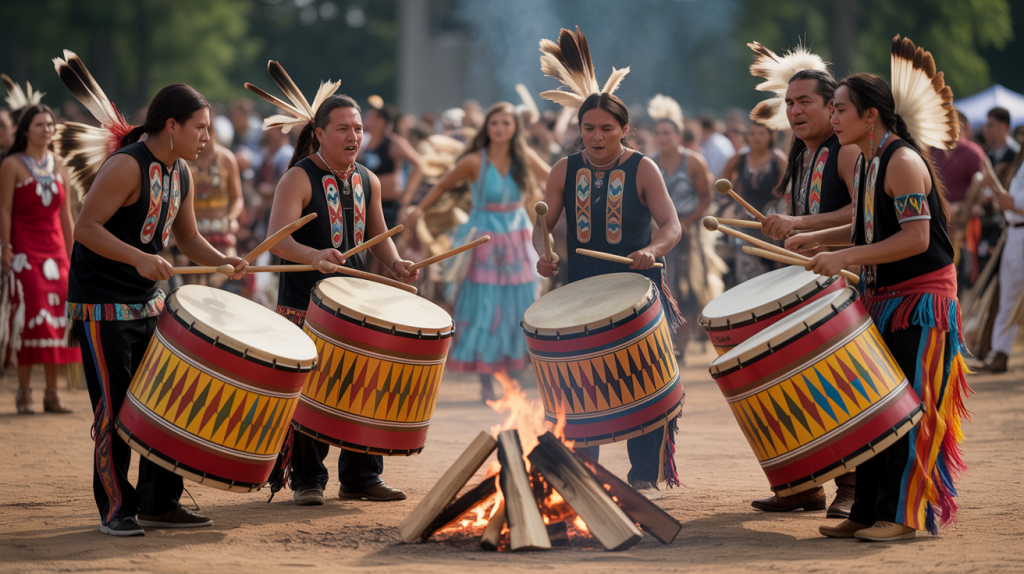
Native American powwow drums are large frame drums that serve as the centerpiece of powwow gatherings and other ceremonial events.
These impressive instruments typically measure between 16 to 24 inches in diameter, though some ceremonial drums can be even larger.
The most distinctive feature of a traditional powwow drum is its construction: a wooden frame, usually made from cedar, cottonwood, or other sacred woods, stretched with rawhide from elk, buffalo, or deer.
The powwow drum construction follows time-honored techniques passed down through generations.
The frame is carefully crafted from bent wood, often steamed and shaped into a perfect circle. The hide, which has been properly prepared through traditional tanning processes, is stretched across both sides of the frame and secured with sinew or strong cord.
This double-headed design creates the drum’s characteristic deep, booming sound that can carry across vast distances.
The Historical Roots of Powwow Drums
Native American powwow drum history stretches back thousands of years, with drums appearing in various forms across different tribal nations throughout North America.
While the large powwow drum as we know it today evolved more recently, the tradition of drumming itself is ancient and sacred.
Different tribes have their own origin stories about how drums came to be. Many speak of the drum as a gift from the Creator, designed to help humans communicate with the spirit world and maintain their connection to the earth.
The Lakota people, for instance, tell of how the first drum was made from the earth itself, with the wooden frame representing the sacred hoop of life and the drumhead symbolizing the surface of the earth.
The modern powwow tradition began to take shape in the late 1800s and early 1900s, as various tribal nations came together and shared their musical traditions.
This intertribal exchange led to the development of the large, shared drum that has become synonymous with powwow gatherings today.
Symbolic Meaning and Cultural Significance
The powwow drum meaning goes far beyond its function as a musical instrument. In many Native American traditions, the drum represents the heartbeat of Mother Earth and serves as a conduit between the physical and spiritual worlds.
When drummers gather around a powwow drum, they’re not just making music—they’re participating in a sacred act that connects them to their ancestors, their community, and the natural world.
The circular shape of the drum holds special significance, representing the sacred hoop of life, the cycles of nature, and the unity of all creation.
The steady beat of the drum mimics the human heartbeat, creating a powerful connection between the individual and the collective consciousness of the community.
Why Are Powwow Drums Sacred and Important?
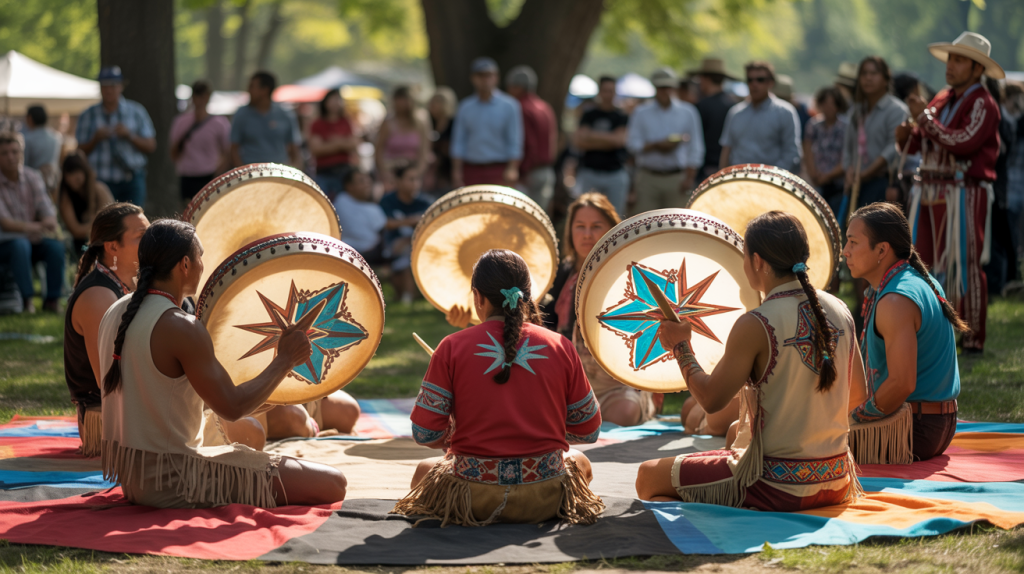
The powwow drum significance extends into virtually every aspect of Native American spiritual and social life.
These instruments are not merely tools for entertainment but serve as sacred objects that facilitate healing, storytelling, prayer, and community bonding.
Spiritual and Ceremonial Role
In powwow drum ceremony contexts, the drum serves as more than an accompaniment to dancing and singing.
It acts as a spiritual anchor that helps participants enter meditative states, connect with ancestral spirits, and experience profound healing.
Many drummers describe feeling a deep spiritual connection when they play, as if the drum is communicating ancient wisdom through their hands.
The spiritual Native American drum tradition recognizes that each drum has its own spirit and personality.
Before a drum is played, it’s often blessed with sage, cedar, or other sacred plants. Drummers may offer prayers or tobacco to honor the animals whose hides were used in the drum’s construction and to ask for guidance during their performance.
Community Connection and Cultural Preservation
Powwow drums play a crucial role in maintaining tribal identity and passing cultural knowledge to younger generations.
When families gather around a drum, they’re participating in an educational experience that teaches respect, cooperation, and cultural values. Children learn songs, stories, and protocols by observing and gradually participating in drum circles.
The collective nature of powwow drumming—where multiple drummers share a single instrument—reinforces important cultural values about cooperation, respect for elders, and the importance of community over individual achievement.
This shared experience creates bonds that extend beyond the drumming circle and into all aspects of community life.
Healing and Therapeutic Benefits
Modern research has begun to validate what Native peoples have known for centuries: drumming has powerful therapeutic benefits.
The rhythmic beating of powwow drums can induce relaxation, reduce stress, and promote emotional healing.
Many contemporary Native American communities incorporate traditional drumming into addiction recovery programs, mental health treatment, and trauma healing initiatives.
The healing power of drumming comes not just from the rhythm itself but from the social connection it creates.
When people drum together, they synchronize their heartbeats and breathing, creating a sense of unity and shared purpose that can be profoundly healing for individuals struggling with isolation or trauma.
Types of Powwow Drums and Regional Variations

Understanding the different types of Native American drums helps appreciate the rich diversity within powwow traditions.
While the large, shared powwow drum is most commonly associated with these gatherings, several variations exist, each with its own purpose and cultural significance.
Large Powwow Drums vs. Hand Drums
The large powwow drum, typically ranging from 18 to 24 inches in diameter, is designed for group playing.
These drums are placed in the center of a circle, with multiple drummers (usually eight or more) seated around them.
The size and construction of these drums create a powerful, penetrating sound that can be heard across large gathering spaces.
In contrast, hand drums are smaller, personal instruments usually measuring 12 to 16 inches in diameter.
These are played by individual drummers and are often used for personal ceremonies, healing work, or intimate gatherings.
While hand drums may accompany powwow activities, they’re not typically used for the main drum circle.
Water drums represent another category entirely. These smaller drums are partially filled with water, which creates a unique, higher-pitched tone.
Water drums are more commonly used in certain ceremonial contexts and are particularly important in some Eastern Woodland traditions.
Northern vs Southern Powwow Drum Styles
One of the most important distinctions in powwow drumming is between Northern and Southern styles, each with its own characteristics in terms of construction, playing technique, and musical approach.
Northern powwow drum styles, prevalent among Plains tribes like the Lakota, Dakota, and Nakota, typically feature drums with a harder, more resonant sound.
Northern drums are often constructed with thicker hides and tighter stretching, creating a sharp, penetrating tone. The drumsticks used in Northern style are typically harder and produce a more defined beat.
Northern singing style is characterized by higher-pitched vocals, with distinct lead singers and chorus responses.
The rhythm patterns in Northern drumming tend to be more complex, with specific honor beats and accents that correspond to dance steps and ceremonial protocols.
Southern powwow drum styles, common among tribes in Oklahoma and the southern Plains, produce a deeper, more mellow sound.
Southern drums are often constructed with softer hides and may be tuned to create a warmer tone. The drumsticks used in Southern style are typically softer, often wrapped with cloth or leather to create a muted sound.
Southern singing is generally characterized by lower-pitched vocals and a more fluid, flowing rhythm.
The drumming patterns in Southern style tend to be more straightforward, with emphasis on maintaining a steady, driving beat that supports the dancers.
Materials and Construction Techniques
Traditional powwow drum construction relies on specific materials chosen for both their acoustic properties and their spiritual significance.
The frame wood is carefully selected, with cedar being particularly prized for its spiritual associations and acoustic qualities. Cedar is considered sacred by many tribes and is believed to carry prayers to the spirit world.
Other woods commonly used include cottonwood, which is readily available in many regions and provides good resonance, and ash, which offers durability and a clear tone. The choice of wood often depends on regional availability and tribal preferences.
The drumhead material is equally important. Elk hide is highly prized for its strength, durability, and tonal qualities.
When properly prepared, elk hide produces a rich, resonant sound that improves with age. Buffalo hide, though less commonly available today, is also highly valued and carries deep spiritual significance for many Plains tribes.
Deer hide is more readily available and is frequently used, especially for smaller drums. While it may not have the same durability as elk or buffalo hide, deer hide can produce excellent tonal qualities when properly prepared and stretched.
The preparation of these hides follows traditional methods that may include natural tanning processes using brain tanning or other indigenous techniques. This preparation is crucial for achieving the proper tone and durability of the finished drum.
How to Choose and Buy an Authentic Powwow Drum

When you’re ready to buy a Native American powwow drum, several important factors should guide your decision.
The most crucial consideration is ensuring that you’re purchasing an authentic drum made by Native artisans who understand and respect the cultural traditions behind these instruments.
The Importance of Authenticity and Cultural Respect
Buying an authentic powwow drum means more than just getting a quality instrument—it means supporting Native communities and ensuring that traditional knowledge and craftsmanship continue to thrive.
Unfortunately, the market contains many mass-produced imitations that lack both the quality and cultural authenticity of traditionally made drums.
When you buy powwow drum instruments from Native makers, you’re participating in a cultural exchange that benefits Indigenous communities.
These purchases help support traditional artisans, preserve ancient techniques, and provide economic opportunities within Native communities.
Authentic powwow drums are made by people who understand the cultural protocols surrounding these instruments.
Native drum makers often incorporate prayers, ceremonies, and traditional techniques into their work, creating instruments that carry spiritual significance along with superior craftsmanship.
What to Look for in Quality Construction
An authentic powwow drum for sale should demonstrate several key characteristics. First, examine the frame construction.
A quality drum will have a frame made from properly seasoned wood, usually cedar or another traditional material. The wood should be free of cracks or defects, and the circular shape should be perfectly round.
The drumhead should be made from genuine animal hide, properly prepared and evenly stretched. Quality hides will have a consistent thickness and should be free from holes or weak spots.
The lacing or attachment method should be secure and traditional, using sinew or strong cord rather than modern synthetic materials.
Pay attention to the overall craftsmanship. A well-made drum will have clean, precise work throughout.
The hide should be evenly tensioned across the entire surface, and the attachment points should be secure and neat.
The drum should have a good balance when held and should produce a clear, resonant tone when played.
Size Considerations
Powwow drums come in various sizes, and choosing the right size depends on your intended use. For group drumming and powwow participation, larger drums (20-24 inches) are typically preferred because they produce the volume and tone quality needed for outdoor gatherings.
Smaller drums (16-18 inches) are more suitable for personal use, indoor ceremonies, or situations where portability is important. These drums are easier to transport and store but may not have the volume needed for large gatherings.
Consider your physical capabilities as well. Larger drums are heavier and require more strength to play effectively.
If you’re planning to travel with your drum or play for extended periods, a medium-sized drum might offer the best balance of tone quality and practicality.
Where to Buy: Trusted Sources
The best places to find authentic Native powwow drum sellers include powwow gatherings, Native American cultural festivals, and established Native artisan networks.
At these events, you can meet the drum makers personally, learn about their techniques, and often watch demonstrations of their craft.
Many reputable Native artisans also sell online through their own websites or through established Native arts organizations.
When buying online, look for detailed information about the artisan’s background, their tribal affiliation, and their training in traditional techniques.
Be cautious of mass-produced drums sold through general music stores or online marketplaces. While these may be less expensive, they typically lack the quality construction and cultural authenticity of traditionally made instruments.
Some museums and cultural centers also offer authentic drums made by Native artisans. These venues often provide educational information about the drums and can connect you with reputable makers.
Powwow Drum Groups and Singing Traditions
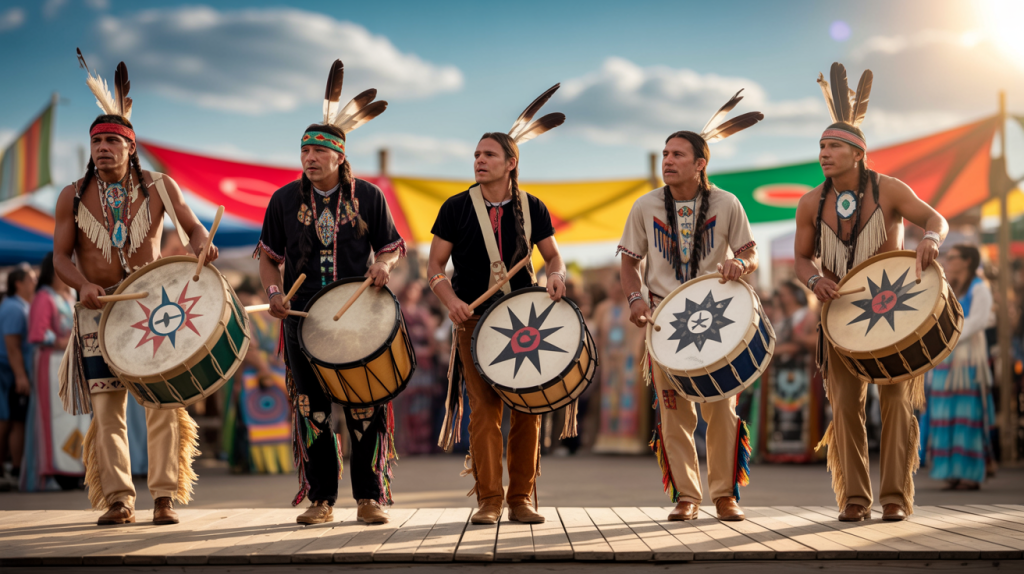
The tradition of Native American drum groups represents one of the most vibrant and dynamic aspects of contemporary powwow culture.
These groups, which can range from family units to large intertribal organizations, carry forward ancient musical traditions while adapting to modern powwow contexts.
The Collective Nature of Powwow Drumming
Traditional powwow drumming is inherently communal. A typical drum circle consists of eight to twelve drummers seated around a single large drum, each contributing to the collective sound while following established protocols and traditions. This arrangement creates a rich, layered sound that no single drummer could achieve on their own.
The lead singer, often the most experienced member of the group, begins each song and sets the tempo. Other drummers join in on the second verse, creating a powerful chorus effect.
The collective approach teaches important cultural values about cooperation, respect for leadership, and the importance of listening to others.
Each drummer in the circle has a responsibility not just to keep time but to support the singers and dancers.
Experienced drummers learn to read the energy of the gathering and adjust their playing accordingly, speeding up or slowing down to match the needs of the dancers.
Gender Roles and Participation
Traditionally, powwow drum singing was primarily a male activity, with women participating as singers from behind the drum rather than as drummers themselves.
However, contemporary powwow culture has evolved to become more inclusive, and women’s participation in drumming has grown significantly.
Many powwows now feature women’s drum groups, and mixed-gender groups are becoming increasingly common.
This evolution reflects both changing social attitudes and efforts to ensure that powwow traditions remain relevant and accessible to all community members.
Women in powwow drumming bring their own perspectives and vocal styles to the tradition. Women’s voices often add a beautiful harmonic element to traditional songs, and all-women’s drum groups have developed their own repertoires and performance styles.
Regional Singing Styles and Honor Beats
Powwow drum singing varies significantly between regions and tribal traditions. Northern style singing, prevalent among Plains tribes, features high-pitched, penetrating vocals with complex harmonies and intricate rhythm patterns.
Northern songs often include specific honor beats—special accents in the drumming that signal important moments in dances or ceremonies.
Southern style singing tends to be lower in pitch with a more flowing, melodic quality. Southern songs often feature longer, more sustained vocals and simpler rhythm patterns.
The honor beats in Southern style are typically more subtle and are used differently than in Northern traditions.
Many drum groups specialize in songs from their own tribal traditions while also learning intertribal songs that can be shared across different powwow communities. This creates a rich musical environment where both traditional and contemporary influences merge.
How to Care For and Maintain a Powwow Drum
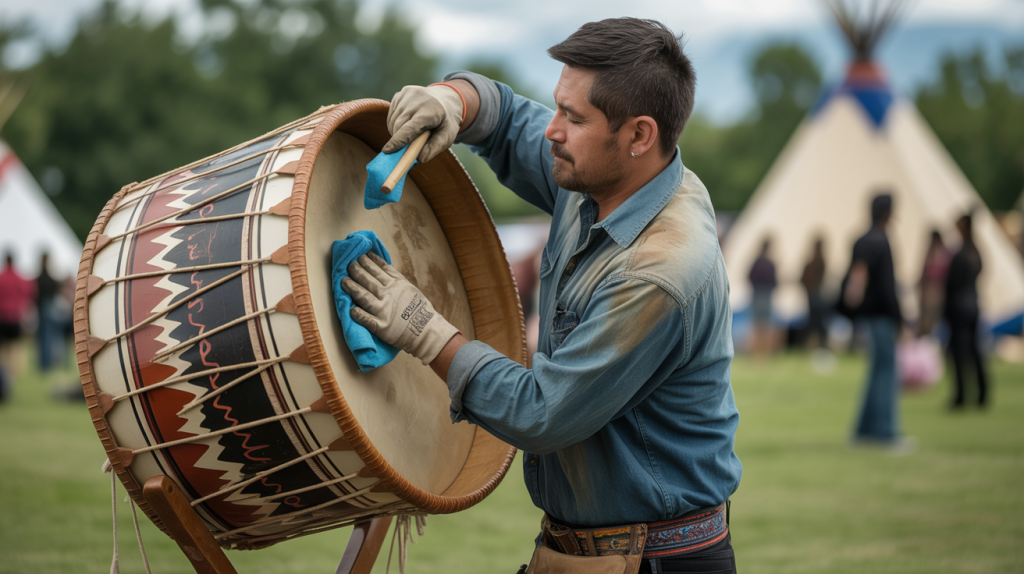
Proper powwow drum care is essential for preserving both the instrument’s sound quality and its spiritual significance. These drums are living instruments that respond to environmental conditions and require thoughtful maintenance to perform their best.
Storage and Environmental Considerations
The most critical aspect of caring for drum skins involves managing humidity and temperature. Rawhide drumheads are highly sensitive to moisture changes, expanding when humid and contracting when dry. This natural response can significantly affect the drum’s tone and tension.
Store your drum in a location with stable humidity levels, away from direct sunlight, heating vents, or air conditioning units.
Rapid temperature changes can cause the hide to crack or the lacing to loosen. A cool, dry room with consistent conditions is ideal.
When transporting your drum, use a padded case or wrap it carefully to protect it from impacts and weather changes.
Many drummers keep their instruments in climate-controlled environments and allow them to acclimate gradually when moving between different conditions.
Cleaning and Maintenance Routines
Regular maintenance keeps your drum in optimal playing condition. Gently dust the drumhead with a soft, dry cloth to remove surface dirt and oils from hands.
Avoid using water or cleaning products on the hide, as these can damage the material and affect the sound.
Inspect the lacing regularly for signs of wear or loosening. Traditional sinew lacing may need periodic tightening, especially during the first few months after the drum is made. Learn the proper techniques for adjusting tension, or consult with the drum maker for guidance.
The wooden frame should be wiped clean occasionally with a dry cloth. If the wood becomes very dry, a small amount of natural oil (like linseed oil) can be applied sparingly, but avoid getting oil on the drumhead.
Dealing with Common Problems
Maintaining Native drums sometimes involves addressing common issues like loose heads, minor cracks, or environmental damage.
If your drumhead becomes too loose due to humidity changes, it may need re-tensioning. This process requires knowledge of traditional lacing techniques and should ideally be learned from an experienced drum maker.
Small cracks in the hide can sometimes be repaired using traditional methods, but major damage may require professional restoration or complete re-heading.
Keep contact information for your drum maker or other knowledgeable artisans who can help with repairs.
If the drum begins to sound dull or loses its resonance, check for loose lacing or frame damage. Sometimes simply adjusting the tension can restore the drum’s voice.
However, remember that drums age and their sound characteristics may change over time—this is a natural part of the instrument’s life cycle.
Powwow Drums in Modern Culture
The role of Native American powwow drums has evolved significantly in contemporary settings while maintaining their deep cultural roots.
Today’s modern Native American powwows blend traditional elements with contemporary innovations, creating dynamic events that serve both cultural preservation and community building functions.
Contemporary Powwow Gatherings
Modern powwows range from intimate community gatherings to large intertribal festivals that attract thousands of participants.
Powwow drum culture today encompasses both traditional ceremonial uses and competitive performance contexts.
Many powwows feature drum contests where groups compete for prizes while showcasing their musical skills and cultural knowledge.
These contemporary gatherings serve multiple purposes: they preserve traditional music and dance, provide economic opportunities for Native communities, educate non-Native audiences about Indigenous culture, and create spaces for cultural exchange between different tribal nations.
The drum remains central to all these activities, providing the rhythmic foundation for dancers and the spiritual anchor for ceremonies.
Modern sound systems may amplify the drums’ voices, but the basic relationship between drummers, singers, and dancers remains unchanged from historical traditions.
Youth Involvement and Cultural Revitalization
One of the most encouraging aspects of modern powwow culture is the active participation of Indigenous youth.
Young people are learning traditional songs, joining drum groups, and carrying forward cultural knowledge that was threatened during periods of cultural suppression.
Powwow drum competitions for youth divisions encourage young drummers to develop their skills while learning about their cultural heritage.
School powwow programs introduce children to drumming traditions and help maintain cultural connections in urban Native communities.
Youth drum groups often blend traditional songs with contemporary influences, creating new music that respects ancestral traditions while speaking to modern experiences. This evolution ensures that powwow culture remains vibrant and relevant for new generations.
Media Representation and Education
Powwow drums have gained increased visibility through documentaries, educational programs, and cultural exhibitions.
This exposure helps combat stereotypes and misconceptions about Native American culture while educating broader audiences about the sophistication and beauty of Indigenous musical traditions.
Many colleges and universities now offer courses on Native American music that include hands-on experience with powwow drumming.
These programs often invite traditional drum groups to campus and provide opportunities for respectful cultural exchange.
Digital platforms have also created new opportunities for sharing powwow music and teaching drumming techniques.
Online tutorials and virtual drum circles help maintain connections within Native communities and provide educational resources for those interested in learning about these traditions.
Learning to Play Powwow Drums
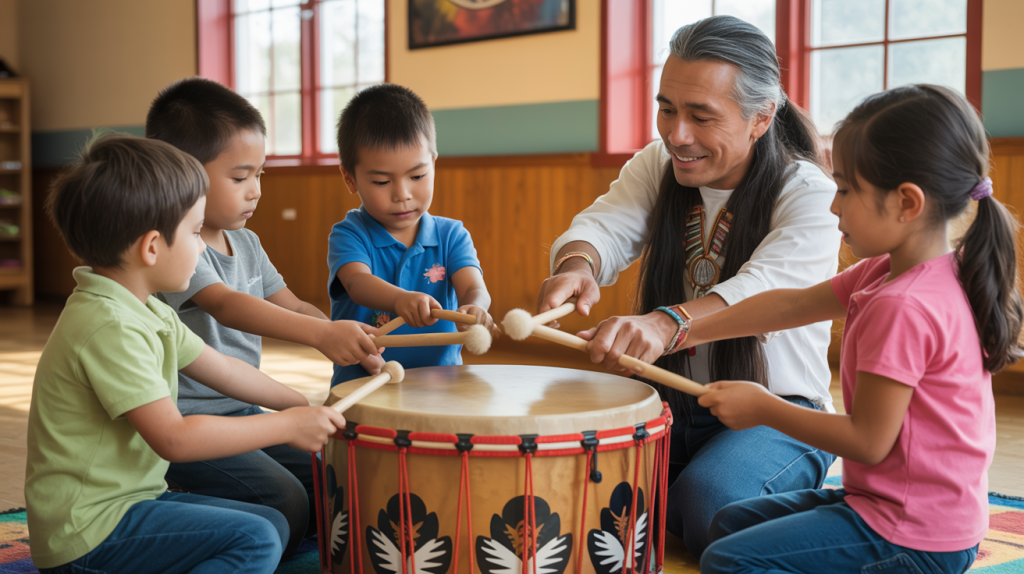
For those interested in learning powwow drumming, approaching this tradition with respect, humility, and proper guidance is essential.
These instruments and their associated protocols represent living cultural traditions that require thoughtful engagement.
Basic Etiquette and Cultural Protocols
Before you can learn powwow drumming effectively, you must understand the cultural protocols that govern these activities.
Proper etiquette includes showing respect for the drum itself, which many consider a sacred object, and following established social protocols within drum circles.
Always ask permission before touching someone else’s drum or drumsticks. Many drummers have specific rituals for handling their instruments, and it’s important to respect these practices.
When joining a drum circle, wait to be invited to participate rather than simply sitting down and beginning to play.
Listen more than you play when you’re learning. Experienced drummers can teach through example, and careful listening helps you understand the subtle nuances of different songs and styles. Pay attention to dynamics, timing, and the relationship between drumming and singing.
Fundamental Rhythm Patterns
Powwow drum rhythm basics center around steady, driving beats that support singers and dancers. The most fundamental pattern is a straight, even beat that maintains consistent tempo throughout a song. This basic rhythm provides the foundation for more complex patterns and variations.
Northern and Southern styles use different rhythmic approaches. Northern drumming often features more complex patterns with specific accents and honor beats, while Southern style tends to emphasize steady, flowing rhythms. Learn the basic patterns for your chosen style before attempting more advanced techniques.
Practice with a metronome to develop steady timing. Consistency is more important than speed when you’re starting out. Focus on producing clean, even beats before worrying about complex rhythms or fast tempos.
Finding Learning Opportunities
The best way to learn powwow drumming is through direct instruction from experienced practitioners.
Look for drum circles, workshops, or cultural events in your area where you can observe and gradually participate under proper guidance.
Many Native American cultural centers offer drumming classes or can connect you with local drum groups willing to accept respectful students.
Community colleges in areas with significant Native populations sometimes offer courses that include traditional music instruction.
Powwow gatherings provide excellent learning opportunities. Attend these events regularly to observe different drum groups, learn various song styles, and understand how drumming fits into the broader cultural context of powwow activities.
Joining or Starting Drum Groups
Native American drum lessons often occur within established drum groups that welcome new members.
These groups provide structured learning environments where beginners can develop their skills while contributing to community activities.
If you’re interested in joining a drum group, approach potential mentors respectfully and be prepared for a gradual learning process.
Most groups prefer to assess new members’ commitment and cultural understanding before fully including them in activities.
Starting your own drum group requires significant cultural knowledge and community support. Consider this option only after you’ve gained substantial experience in established groups and have developed relationships with mentors who can guide your efforts.
Frequently Asked Questions About Powwow Drums
What types of wood are used in powwow drums?
Traditional powwow drum wood includes cedar, which is highly prized for its spiritual significance and acoustic properties.
Cedar is considered sacred by many tribes and produces excellent resonance. Cottonwood is another popular choice, particularly in areas where it grows naturally. This wood is readily available and provides good sound quality while being relatively lightweight.
Other woods used include ash, which offers durability and a clear tone, and sometimes maple or other hardwoods depending on regional availability and tribal preferences.
The choice of wood often reflects both practical considerations (what’s available locally) and cultural traditions specific to different tribal nations.
Can women drum at powwows?
Women powwow drummers are increasingly common in contemporary powwow culture, though traditions vary among different tribes and regions.
Historically, women typically participated as singers standing behind the drum rather than as drummers themselves. However, modern powwow culture has evolved to become more inclusive.
Today, many powwows feature women’s drum groups, and mixed-gender drumming is becoming more accepted. Some events have specific categories for women’s groups in their competitions.
This evolution reflects changing social attitudes and efforts to ensure that cultural traditions remain accessible to all community members while respecting historical protocols.
How loud is a powwow drum?
A properly made powwow drum can produce sound levels comparable to other percussion instruments, often reaching 100-110 decibels when played vigorously.
The large size and construction of these drums create powerful, penetrating sound that can carry across outdoor gathering spaces without amplification.
The volume level depends on several factors: the drum’s size, the type and thickness of the hide, the playing technique, and the number of drummers.
During competitions or large gatherings, the sound can be quite intense, which is why many powwows now use sound systems to balance the audio levels for audience comfort.
What is the significance of the powwow drum’s size?
Powwow drum symbolism related to size reflects both practical and spiritual considerations. Larger drums produce deeper, more resonant tones that can carry across greater distances—essential for outdoor gatherings.
The size also affects the number of drummers who can comfortably sit around the instrument, with larger drums accommodating bigger groups.
Spiritually, the drum’s size can represent the magnitude of its role in community life. A large drum serves as a focal point that draws people together, symbolizing unity and shared purpose.
Some traditions associate drum size with the instrument’s power to connect the community with spiritual forces and ancestral wisdom.
The circular shape, regardless of size, represents completeness, the sacred hoop of life, and the cycles of nature that govern traditional Indigenous worldviews.
Conclusion: Honoring the Sacred Heartbeat
Native American powwow drums represent far more than musical instruments—they embody centuries of cultural wisdom, spiritual practice, and community connection.
Throughout this comprehensive exploration, we’ve discovered how these magnificent instruments serve as bridges between past and present, connecting contemporary Native communities with their ancestral traditions while adapting to modern contexts.
Whether you’re considering your first purchase of an authentic powwow drum, seeking to deepen your understanding of Native American culture, or simply appreciating the artistry and spirituality these instruments represent, remember that you’re engaging with living traditions that continue to evolve and thrive.
The journey of understanding powwow drums teaches us about respect, community, and the power of music to heal and unite.
When you buy powwow drum instruments from Native makers, participate in drum circles, or simply listen with appreciation to powwow music, you’re supporting cultural preservation and contributing to the vitality of these ancient traditions.
As we’ve learned, the sacred heartbeat of the powwow drum continues to resonate through Native communities, calling people together for celebration, ceremony, and cultural renewal.
These instruments remind us that some traditions transcend time, carrying essential human truths about connection, respect, and the power of collective expression.
For those inspired to explore this world further, remember to approach these traditions with humility and respect.
Attend powwows, support Native artisans, and seek authentic learning opportunities that honor the cultural protocols surrounding these sacred instruments.
In doing so, you become part of a continuous circle of cultural appreciation and preservation that ensures the heartbeat of Native American traditions will continue for generations to come.
The traditional Native American powwow drum stands as a testament to the resilience and beauty of Indigenous culture.
May its voice continue to call communities together, heal hearts, and preserve the precious wisdom of America’s first peoples.
Source: Powwow music and its Polymetric Construction
Related Post: Native American Music






